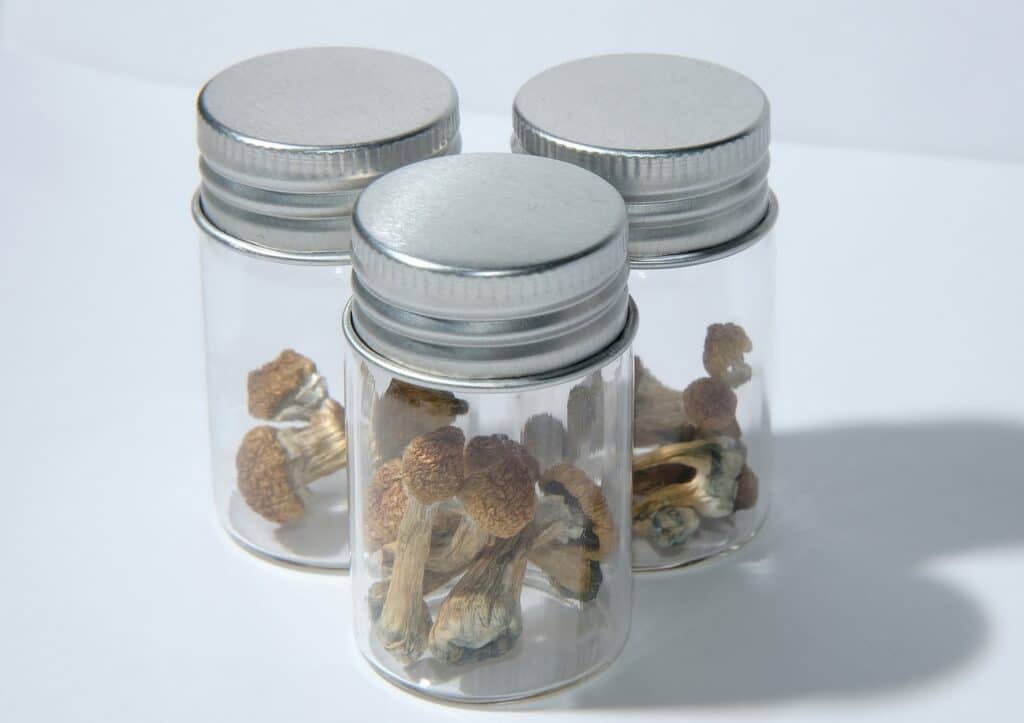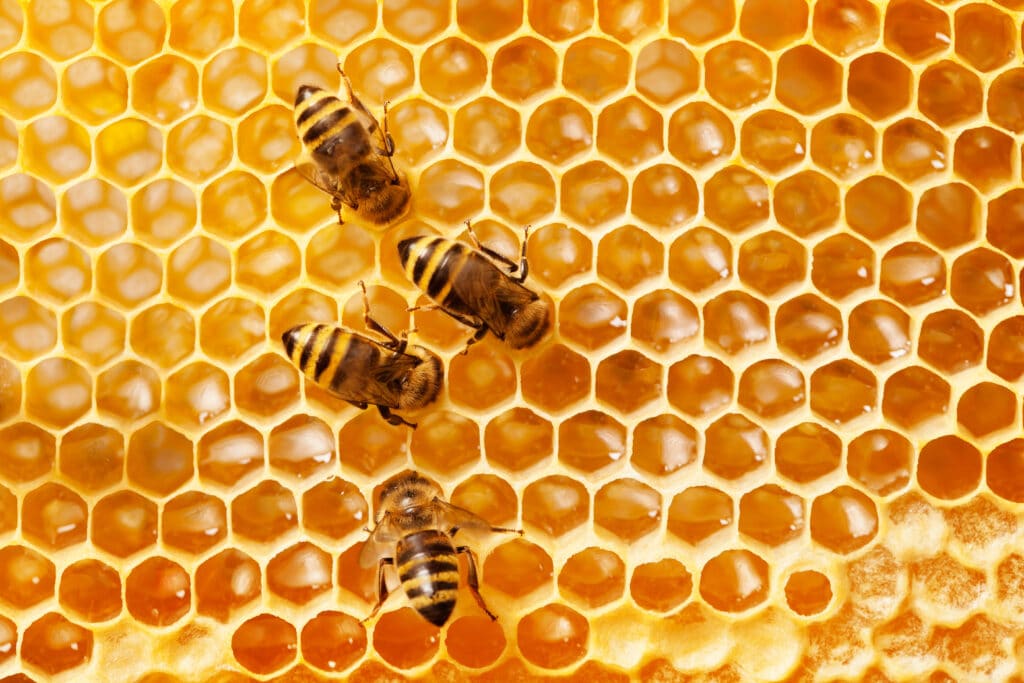
What is the “Blue Honey” Method of Storing Magic Mushrooms?
[ad_1]
Everyone is talking about magic mushrooms lately. From industry insiders who are looking to capitalize to street dealers who are doing the same, a huge range of consumers want to benefit from their use, including experienced psychonauts who just enjoy the ride, average people who want to know what the fuss is about, government employees trying to manage their PTSD, individuals young and old suffering from mental health disorders, and everyone in between.
That being said, the general public still knows very little about shrooms. Things like dosing, purchasing options, and storage methods remain a mystery for those who are just beginning to dip their toes in the psychedelic waters. Today, we’ll be taking a look at one of the more obscure, yet also rewarding, methods of storing psilocybin mushrooms: the blue honey method.
What are magic mushrooms?
Magic mushrooms belong to a group of fungi containing the hallucinogenic compound psilocybin (and/or trace amounts of psilocin). For the sake of simplicity and because amanitas are not subject to bluing, we’ll be leaving them out of today’s discussion. Psilocybin mushrooms are similar to other hallucinogens like LSD and DMT in that they all attach to serotonin receptors to create a psychoactive response. Some examples of popular magic mushrooms include Panaeolus, Conocybe, and Psilocybe, the most well-known.
While different hallucinogens are known for causing different reactions or trips, there are some underlying similarities among all of them, such as visual, sensory, and auditory hallucinations, feelings of spirituality, euphoria, connectedness, introspection, and overall well-being, and experiencing mystical and otherworldly encounters.
Although all magic mushrooms contain psilocybin, their potency varies and is based on the level of active compounds in each strain. What’s great about mushrooms in comparison to other hallucinogens is that you can really customize your dose from a microdose of 0.1 to 0.3 grams all the way to what’s known as a heroic dose, which is typically 5 grams or more in one sitting.
Like all other psychedelics, the active compounds in mushrooms are listed as Schedule 1 narcotics in the DEA’s list of controlled substances. Although both psilocybin and psilocin are listed, it’s worth noting that psilocybin is the real active compound in these mushrooms. To feel the effects of psilocybin, our bodies convert it to psilocin, which also exists in trace amounts in mushrooms.
Storing shrooms
Storing magic mushrooms is vital if you plan on keeping them for an extended period of time. They are very sensitive to the environment and susceptible to damage, which diminishes their alkaloid content and degrades the psilocybin in them. This makes them prone to early decomposition. Keeping your shrooms in the right conditions is pretty simple, and it’s an absolute must for psychonauts, cultivators, and retailers alike.
Magic mushrooms aren’t a substance that most people use on a regular basis. So, if you buy a larger amount (an ounce or more, let’s say), you’re likely to have some leftovers after your trippy experience. Or if you’re growing mushrooms yourself, you know you’ll end up with a larger amount than one person can use in a single sitting. Either way, an oversupply of psilocybin mushrooms means they will need to be stored in a certain way to ensure their longevity and potency. But how to store mushrooms and how long they last depends on a few different factors.

For example, freshly harvested mushrooms can be kept on a paper towel or in a paper bag in the refrigerator, but they will only last a couple of days. So if you don’t plan on using them immediately, your next step would be to dry them, either on a drying rack or in a dehydrator, until they are completely dry. Seriously, 100 percent dry, as any moisture can cause the psilocybin in the shrooms to break down and degrade.
If you’re starting off with dried mushrooms already, proper storage can keep them usable for about a year. Most people opt for airtight jars or vacuum-sealed packages, both of which are practical and affordable solutions. A more unique method, and one that is equally cost-friendly but requires a bit more patience, is the “blue honey” method, described in detail below.
The blue honey method
One interesting storage option that I’m going to try with my next flush is the “blue honey method”. The name blue honey comes from the blue hue magic mushrooms get when they are cut; however, the honey itself is not typically blue. To make blue honey, you take your dried mushrooms or truffles and grind them up as finely as possible. Then mix them into some high-quality, raw, unfiltered (and preferably local) honey. Again, it’s extremely important that your shrooms be completely dry before grinding because any moisture can cause the honey to ferment.
You can use the honey in tea, on deserts, or simply eat a few spoonfuls for a tasty, psychedelic treat. What’s possibly best about this method is that it preserves the psilocybin indefinitely, as raw honey doesn’t degrade over time. If the honey ever starts clumping and crystalizing, just run the jar under some warm water, and it goes right back to normal.
Benefits of honey
Honey is food for bees, made by bees, but we humans and many other creatures enjoy it as well. Not only is it delicious, but it’s rich in a variety of nutrients and antioxidants that can be beneficial to our health. It also has antimicrobial and antifungal properties, can protect the body from inflammation, and can help prevent several ailments, including heart disease, cancer, and autoimmune disorders.

For example, one study found that buckwheat honey was full of antioxidants that were detectable in blood plasma, meaning that those specific antioxidants definitively enhanced antioxidant activity in the body. Additionally, honey is high in polyphenols and flavonoids, which also act as antioxidants in the body. These compounds can help protect the body from different types of cell damage.
Another study on honey that looked at over 4,500 participants over the age of 40 found that it can help prevent heart disease by “lowering blood pressure, improving blood fat levels, regulating your heartbeat, and preventing the death of healthy cells”. The same team also conducted a rodent study that found honey could help shield the heart from oxidative stress.
Raw, unfiltered honey also contains propolis, a bee-produced resin that comes from trees with sap and similar plants. A study on propolis found that it can help improve cholesterol and triglyceride levels. According to their data, “levels of total cholesterol, LDL (or bad) cholesterol, and triglycerides went down in people who had 70 grams of honey (about 2.5 ounces) each day for 4 weeks. Their HDL (or good) cholesterol also increased”
Final thoughts
Obviously, there are only certain circumstances in which the blue honey method would be feasible. If you only have a limited number of mushrooms and plan to use them over the course of the next few months, then you might as well just stick to vacuum-sealed or mason jars. But if you have an abundance, or if you think your shrooms would just sit around for a while, then chopping them up and throwing them into a jar of honey to “ferment,” so to speak, is a pretty solid ideal. I know I’ll be trying it out with part of my next flush, so check back for updates!
Welcome, cannabis aficionados! Thanks for making your way to Cannadelics.com, an independent news site going deep into the worlds of cannabis, psychedelics, and well beyond. We’re big on updates, so come by regularly. And get yourself signed up to the Cannadelics Weekly Newsletter, for the best in related product offerings as well.
Related
[ad_2]


